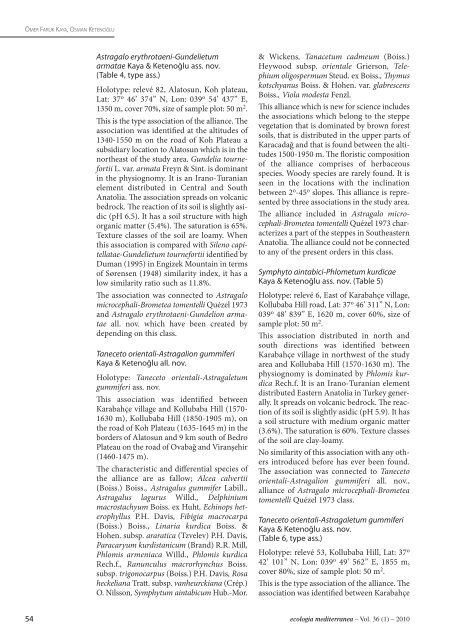Revue internationale d'écologie méditerranéenne International ...
Revue internationale d'écologie méditerranéenne International ...
Revue internationale d'écologie méditerranéenne International ...
Create successful ePaper yourself
Turn your PDF publications into a flip-book with our unique Google optimized e-Paper software.
ÖmEr FArUK KAyA, OSmAn KETEnOğlU<br />
54<br />
Astragalo erythrotaeni-Gundelietum<br />
armatae Kaya & Ketenoğlu ass. nov.<br />
(Table 4, type ass.)<br />
Holotype: relevé 82, Alatosun, Koh plateau,<br />
Lat: 37o 46’ 374’’ N, Lon: 039o 54’ 437’’ E,<br />
1350 m, cover 70%, size of sample plot: 50 m2 .<br />
is is the type association of the alliance. e<br />
association was identified at the altitudes of<br />
1340-1550 m on the road of Koh Plateau a<br />
subsidiary location to Alatosun which is in the<br />
northeast of the study area. Gundelia tournefortii<br />
L. var. armata Freyn & Sint. is dominant<br />
in the physiognomy. It is an Irano-Turanian<br />
element distributed in Central and South<br />
Anatolia. e association spreads on volcanic<br />
bedrock. e reaction of its soil is slightly asidic<br />
(pH 6.5). It has a soil structure with high<br />
organic matter (5.4%). e saturation is 65%.<br />
Texture classes of the soil are loamy. When<br />
this association is compared with Sileno capitellatae-Gundelietum<br />
tournefortii identified by<br />
Duman (1995) in Engizek Mountain in terms<br />
of Sørensen (1948) similarity index, it has a<br />
low similarity ratio such as 11.8%.<br />
e association was connected to Astragalo<br />
microcephali-Brometea tomentelli Quézel 1973<br />
and Astragalo erythrotaeni-Gundelion armatae<br />
all. nov. which have been created by<br />
depending on this class.<br />
Taneceto orientali-Astragalion gummiferi<br />
Kaya & Ketenoğlu all. nov.<br />
Holotype: Taneceto orientali-Astragaletum<br />
gummiferi ass. nov.<br />
is association was identified between<br />
Karabahçe village and Kollubaba Hill (1570-<br />
1630 m), Kollubaba Hill (1850-1905 m), on<br />
the road of Koh Plateau (1635-1645 m) in the<br />
borders of Alatosun and 9 km south of Bedro<br />
Plateau on the road of Ovabağ and Viranşehir<br />
(1460-1475 m).<br />
e characteristic and differential species of<br />
the alliance are as fallow; Alcea calvertii<br />
(Boiss.) Boiss., Astragalus gummifer Labill.,<br />
Astragalus lagurus Willd., Delphinium<br />
macrostachyum Boiss. ex Huht, Echinops heterophyllus<br />
P.H. Davis, Fibigia macrocarpa<br />
(Boiss.) Boiss., Linaria kurdica Boiss. &<br />
Hohen. subsp. araratica (Tzvelev) P.H. Davis,<br />
Paracaryum kurdistanicum (Brand) R.R. Mill,<br />
Phlomis armeniaca Willd., Phlomis kurdica<br />
Rech.f., Ranunculus macrorhynchus Boiss.<br />
subsp. trigonocarpus (Boiss.) P.H. Davis, Rosa<br />
heckeliana Tratt. subsp. vanheurckiana (Crép.)<br />
O. Nilsson, Symphytum aintabicum Hub.-Mor.<br />
& Wickens, Tanacetum cadmeum (Boiss.)<br />
Heywood subsp. orientale Grierson, Telephium<br />
oligospermum Steud. ex Boiss., ymus<br />
kotschyanus Boiss. & Hohen. var. glabrescens<br />
Boiss., Viola modesta Fenzl.<br />
is alliance which is new for science includes<br />
the associations which belong to the steppe<br />
vegetation that is dominated by brown forest<br />
soils, that is distributed in the upper parts of<br />
Karacadağ and that is found between the altitudes<br />
1500-1950 m. e floristic composition<br />
of the alliance comprises of herbaceous<br />
species. Woody species are rarely found. It is<br />
seen in the locations with the inclination<br />
between 2 o -45 o slopes. is alliance is represented<br />
by three associations in the study area.<br />
e alliance included in Astragalo microcephali-Brometea<br />
tomentelli Quézel 1973 characterizes<br />
a part of the steppes in Southeastern<br />
Anatolia. e alliance could not be connected<br />
to any of the present orders in this class.<br />
Symphyto aintabici-Phlometum kurdicae<br />
Kaya & Ketenoğlu ass. nov. (Table 5)<br />
Holotype: relevé 6, East of Karabahçe village,<br />
Kollubaba Hill road, Lat: 37o 46’ 311’’ N, Lon:<br />
039o 48’ 839’’ E, 1620 m, cover 60%, size of<br />
sample plot: 50 m2 .<br />
is association distributed in north and<br />
south directions was identified between<br />
Karabahçe village in northwest of the study<br />
area and Kollubaba Hill (1570-1630 m). e<br />
physiognomy is dominated by Phlomis kurdica<br />
Rech.f. It is an Irano-Turanian element<br />
distributed Eastern Anatolia in Turkey generally.<br />
It spreads on volcanic bedrock. e reaction<br />
of its soil is slightly asidic (pH 5.9). It has<br />
a soil structure with medium organic matter<br />
(3.6%). e saturation is 60%. Texture classes<br />
of the soil are clay-loamy.<br />
No similarity of this association with any others<br />
introduced before has ever been found.<br />
e association was connected to Taneceto<br />
orientali-Astragalion gummiferi all. nov.,<br />
alliance of Astragalo microcephali-Brometea<br />
tomentelli Quézel 1973 class.<br />
Taneceto orientali-Astragaletum gummiferi<br />
Kaya & Ketenoğlu ass. nov.<br />
(Table 6, type ass.)<br />
Holotype: relevé 53, Kollubaba Hill, Lat: 37 o<br />
42’ 101’’ N, Lon: 039 o 49’ 562’’ E, 1855 m,<br />
cover 80%, size of sample plot: 50 m 2 .<br />
is is the type association of the alliance. e<br />
association was identified between Karabahçe<br />
ecologia mediterranea – Vol. 36 (1) – 2010
















